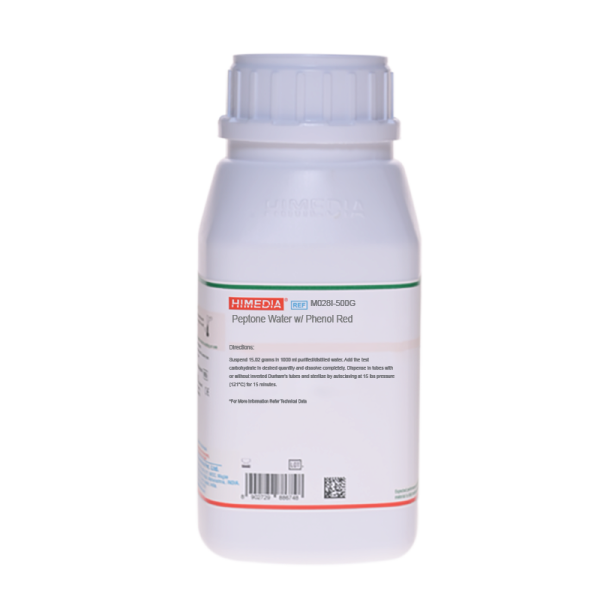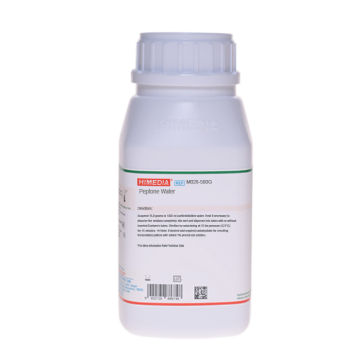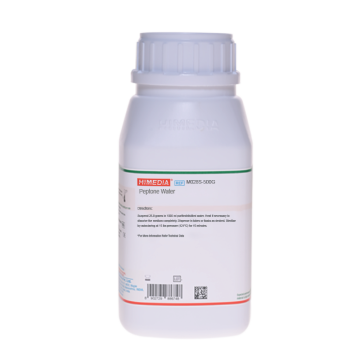 Your enquiry has been submitted
Your enquiry has been submitted
Peptone Water w/ Phenol Red
Intended Use:
Recommended for studying fermentation ability of Yersinia enterocolitica. The composition and performance criteria of this medium are in accordance with ISO 10273:2017.
Composition**
| Ingredients | g/L |
|---|---|
| Peptone | 10.000 |
| Sodium chloride | 5.000 |
| Phenol red | 0.020 |
| Final pH (at 25°C) | 6.8±0.2 |
**Formula adjusted, standardized to suit performance parameters
Directions
Suspend 15.02 grams in 1000 ml purified/ distilled water. Add the test carbohydrate in desired quantity and dissolve completely. Dispense in tubes with or without inverted Durhams tubes and sterilize by autoclaving at 15 lbs pressure (121°C) for 15 minutes. Cool to 45-50° С.
Principle And Interpretation
Peptone Water is particularly suitable as a substrate in the study of indole production. Peptone used in Peptone Water is rich in tryptophan content. Peptone Water is also utilized as a base for carbohydrate fermentation studies with the addition of sugar and indicators such as bromocresol purple, phenol red or bromothymol blue. Peptone Water with Phenol Red is recommended for studying the ability of an organism to ferment a specific carbohydrate which aid in differentiation of genera and species (1,2,3). The formulation of Peptone Water makes it useful for cultivating non-fastidious organisms (4). This medium is recommended to study fermentation reactions of Yersinia enterocolitica. Peptone Water with pH adjusted to 8.4 is suitable for the cultivation and enrichment of Vibrio species. Peptone provides essential nutrients. Sodium chloride maintains the osmotic balance of the medium. Fermentation ability of microorganisms is studied by addition of carbohydrates separately to the basal medium before or after sterilization, such as saccharose, rhamnose, salicin, glucose, dextrose etc. at a concentration of 0.5%. Most of the end products of carbohydrate fermentation are organic acids, which, in the presence of phenol red, show a colour change of the medium from red to yellow. If desired, Durhams tube may be used to detect the gas production if produced. The addition of some sugars can lower the pH of the medium. That can be adjusted with sterile 0.1 N NaOH.
Type of specimen
Food samples
Specimen Collection and Handling:
For food samples, follow appropriate techniques for sample collection and processing as per guidelines (4). After use, contaminated materials must be sterilized by autoclaving before discarding.
Warning and Precautions :
Read the label before opening the container. Wear protective gloves/protective clothing/eye protection/ face protection. Follow good microbiological lab practices while handling specimens and culture. Standard precautions as per established guidelines should be followed while handling specimens. Safety guidelines may be referred in individual safety data sheets.
Limitations :
- Due to variable nutrient requirements some strains may show poor growth.
Performance and Evaluation
Performance of the medium is expected when used as per the direction on the label within the expiry period when stored at recommended temperature.
Quality Control
Appearance Light yellow to light pink homogeneous free flowing powder
Colour and Clarity of prepared medium Red coloured clear solution without any precipitate
Reaction Reaction of 1.5% w/v aqueous solution at 25°C. pH: 6.8±0.2
pH 6.60-7.00
Cultural Response
Cultural characteristics observed after an incubation at 35-37°C for 18-24 hours.
| Organism | Growth | L(+)Rhamnose Saccharose (Acid) | Salicin (Acid) | |
|---|---|---|---|---|
| Yersinia enterocolitica ATCC 27729 | luxuriant | positive reaction (moderate) | positive reaction | negative reaction |
| Yersinia pseudotuberculosis ATCC 29833 | luxuriant | positive reaction (occasional strain are rhamnose positive) | negative reaction | positive reaction |
Storage and Shelf Life
Store between 10-30°C in a tightly closed container and the prepared medium at 15-30°C. Use before expiry date on the label. On opening, product should be properly stored dry, after tightly capping the bottle inorder to prevent lump formation due to the hygroscopic nature of the product. Improper storage of the product may lead to lump formation. Store in dry ventilated area protected from extremes of temperature and sources of ignition. Seal the container tightly after use. Product performance is best if used within stated expiry period.
Disposal
User must ensure safe disposal by autoclaving and/or incineration of used or unusable preparations of this product. Follow established laboratory procedures in disposing of infectious materials and material that comes into contact with sample must be decontaminated and disposed of in accordance with current laboratory techniques (5,6).
Reference
- Finegold S. M. and Baron E. J., 1986, Bailey and Scotts Diagnostic Microbiology, 7th Ed., The C.V. Mosby Co., St. Louis.
- MacFaddin J. F., 1985, Media for Isolation-Cultivation-Identification-Maintenance of Medical Bacteria, Vol. 1, Williams and Wilkins, Baltimore.
- Murray P. R., Baron J. H., Pfaller M. A., Jorgensen J. H. and Yolken R. H., (Eds.), 2003, Manual of Clinical Microbiology, 8th Ed., American Society for Microbiology, Washington, D.C.
- International Organization for Standardization (ISO), 1994 Draft ISO/DIS 10273.
- Isenberg, H.D. Clinical Microbiology Procedures Handbook 2nd Edition.
- Jorgensen, J.H., Pfaller, M.A., Carroll, K.C., Funke, G., Landry, M.L., Richter, S.S and Warnock., D.W. (2015) Manual of Clinical Microbiology, 11th Edition. Vol. 1.
| Product Name | Peptone Water w/ Phenol Red |
|---|---|
| SKU | M028I |
| Product Type | Regular |
| Physical Form | Powder |
| Origin | Animal |
| Packaging type | HDPE |
| References | 1. MacFaddin J., 1980, Biochemical Tests for Identification of Medical Bacteria, 2nd ed., Williams and Wilkins, Baltimore. 2.Finegold and Baron, 1986, Bailey and Scotts Diagnostic Microbiology, 7th ed., The C.V. Mosby Co., St. Louis. 3.Lennette and others (Eds.), 1985, Manual of Clinical Microbiology, 4th ed, ASM, Washington, D.C. 4.Shread P., Donovan T.J, and Lee J.V, (1981), Soc. Gen, Microbiol. Q., 8, 184. 5.Isenberg, H.D. Clinical Microbiology Procedures Handb0ook. 2nd Edition. 6.Jorgensen,J.H., Pfaller , M.A., Carroll, K.C., Funke, G., Landry, M.L., Richter, S.S and Warnock., D.W. (2015)Manual of Clinical Microbiology, 11th Edition. Vol. 1. 7.American Public Health Association, Standard Methods for the Examination of Dairy Products, 1978, 14th Ed., WashingtonD.C. 8.Salfinger Y., and Tortorello M.L. Fifth (Ed.), 2015, Compendium of Methods for the Microbiological Examination ofFoods, 5th Ed., American Public Health Association, Washington, D.C. 9.Baird R.B., Eaton A.D., and Rice E.W., (Eds.), 2015, Standard Methods for the Examination of Water andWastewater, 23rd ed., APHA, Washington, D.C. 10.Wehr H. M. and Frank J. H., 2004, Standard Methods for the Microbiological Examination of Dairy Products, 17th Ed.,APHA Inc., Washington, D.C. |
| Customized Product Available | No |









